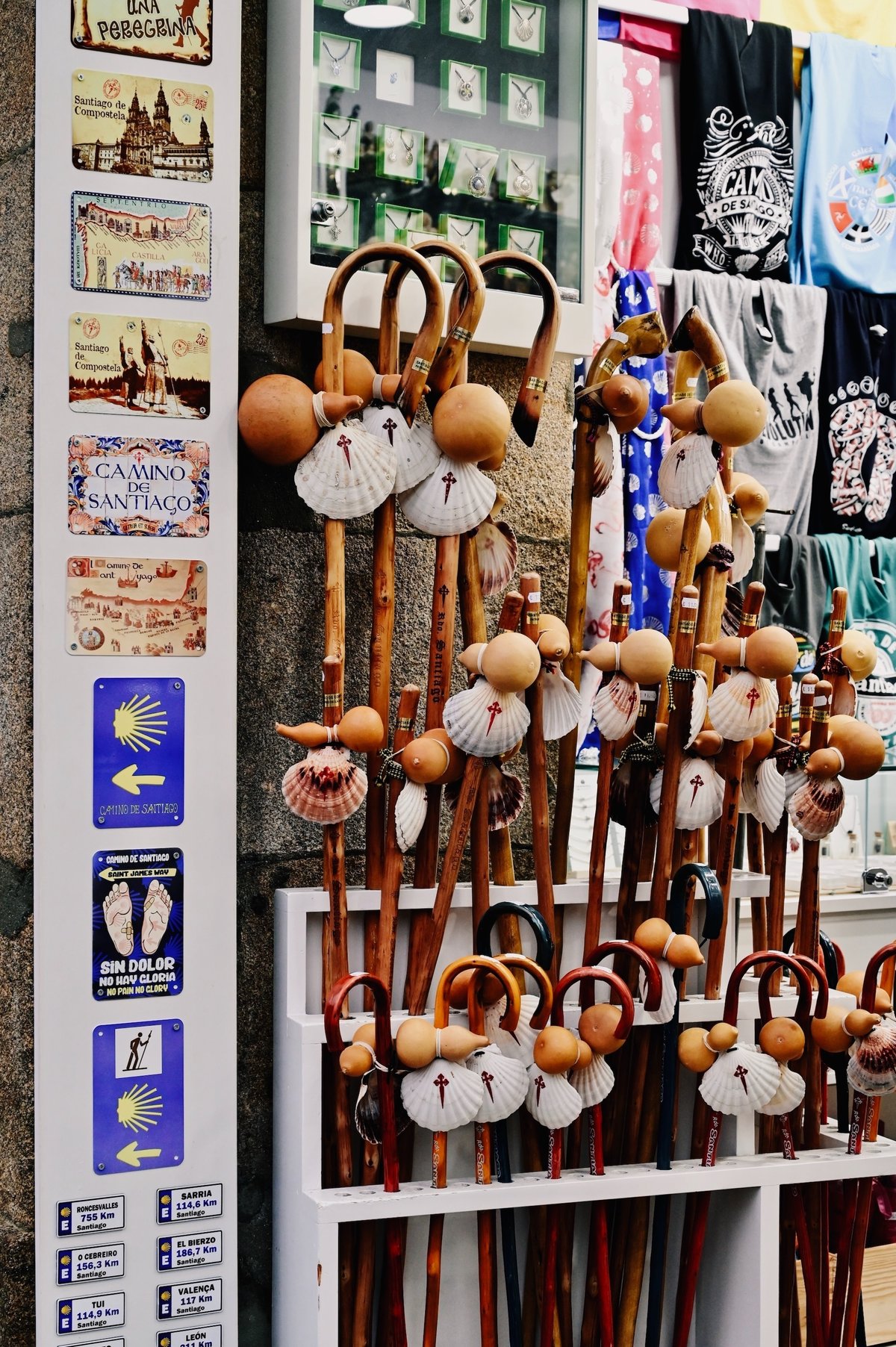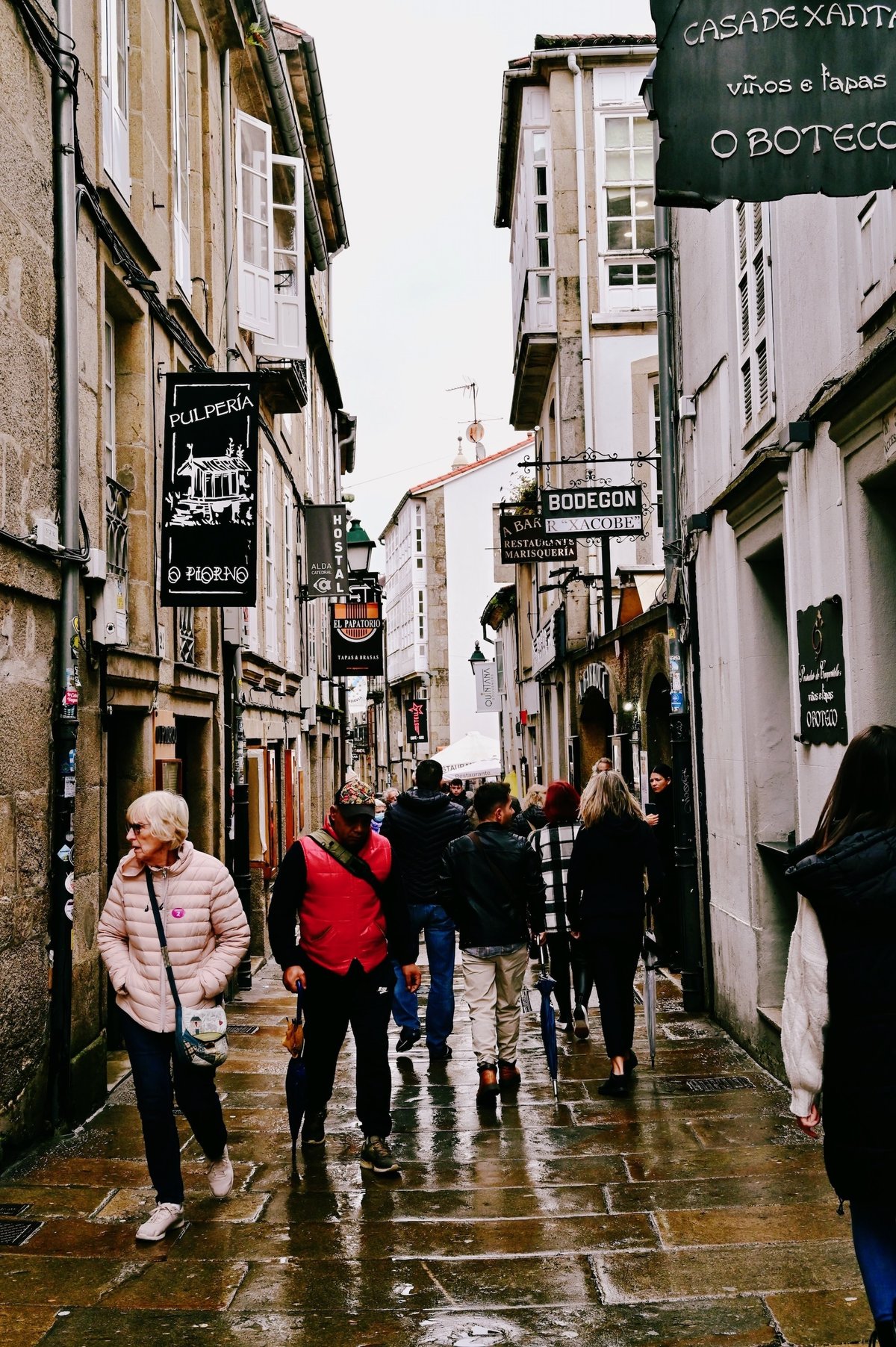
ガリシア3:サンティアゴ・デ・コンポステーラで魚介三昧
2022年10月に訪れたスペイン・ガリシア州で食べた美味いもの食い倒れ紀行です。第3回はサンティアゴ・デ・コンポステーラの市場で魚介を買い込んでその場で爆食い!
English Follows Japanese
ビーゴからサンティアゴ・デ・コンポステーラへ
2022年10月26日夕方、ガリシア州の港町ビーゴから特急電車に乗り、次の目的地サンティアゴ・デ・コンポステーラへ向かった。1時間弱の道のりの途中、青唐辛子「パドロン」の名の由来となった町パドロンの駅を通過。ガリシアに着いてから毎日のように食べていたこの唐辛子が、まさにこの土地の特産物であることを再認識しつつ、電車は進む。

予想していたよりもはるかに小さな国鉄駅に到着し、タクシーに乗って旧市街の西側の森林地帯にある中世の修道院を改装した宿「Paracio del Carmen」に到着。宿坊を元にした狭い部屋にチェックインし、窓を開けると目の前には緑の森と、その奥に広がる緩やかな丘陵が広がっていた。空はどんよりとした鉛色で、しとしとと雨が降り始めていた。本格的に降り出す前に街歩きに出かけよう。

サンティアゴ・デ・コンポステーラの歴史
ガリシア州の州都サンティアゴ・デ・コンポステーラはキリスト教徒にとって最も重要な巡礼地の一つ。サンティアゴ・デ・コンポステーラという名前は「星の野原(コンポステーラ)の聖ヤコブ(サンティアゴ)」という意味を持つ。
聖ヤコブはイエス・キリストの十二使徒の一人で、キリストの教えを広めるため中東からわざわざ地中海を渡り、イベリア半島にて伝道を行った。彼はエルサレムで殉教したが、その遺体はわざわざイベリア半島に運ばれ、ガリシアで埋葬された…とされている。それから約800年後、キリスト教の隠者ペラヨが天使の声と空に輝く不思議な星に導かれて、聖ヤコブの墓を発見した。現代人なら「そんなことありえないよ!」と言えるが、当時のスペイン=イベリア半島の歴史を知ると、この奇跡のような出来事がどうしても必要だったことがわかる。

イベリア半島は8世紀初頭にイスラーム王朝のウマイヤ朝に侵略され、全土がその支配下となった。ほどなくウマイヤ朝は後ウマイヤ朝に引き継がれた。するとガリシアを含むイベリア半島北部はイスラーム教徒に奪われた土地をキリスト教徒が奪回する「レコンキスタ(国土回復)」運動の最前線となった。要はキリスト教徒が一丸となるための奇跡とシンボルが早急に必要になった……まさしく「信じる者は救われる!」というわけだ。
この奇跡的な発見(現代の言葉で言うなら「ポスト・トゥルース」だ)を記念して。この地はサンティアゴ・デ・コンポステーラと名付けられた。ヨーロッパ各地から多くの巡礼者がスペイン北部を横断する約800kmにも及ぶ道、「カミーノ・デ・サンティアゴ(サンティアゴの道)」を通ってこの地を目指し始めたのだ。こうして人々の信仰心と愛郷心に基づいた新たな聖地建立計画がスタートした。

その後12世紀には聖ヤコブの遺骸を安置するためのサンティアゴ・デ・コンポステーラ大聖堂が完成し、この街はローマ、エルサレムと並ぶキリスト教世界の三大巡礼地の一つとなった。現在も年間40万人(2022年)を超える人々が世界中からスペイン北部に集まり、徒歩やバス、自動車など様々な方法で巡礼を行なっている。
おかげでサンティアゴ・デ・コンポステーラの旧市街は1985年とかなり早い時期にユネスコ世界遺産に登録され、巡礼路「カミーノ・デ・サンティアゴ」も1993年には世界遺産に登録されている。質実剛健な商業都市のビーゴとは違い、サンティアゴ・デ・コンポステーラは1000年以上もの歴史を持つ筋金入りの宗教観光地ということだ。
大聖堂への道
宿を出て東へ5分ほど、森林に囲まれた住宅地を歩くと旧市街の西側の入り口に着いた。そこからは中世ヨーロッパらしい石畳の坂道が続き、道の両側には中世の小さな建物を改装したブティックホテルやB&B、レストランが軒を連ねている。
坂道を5分ほど上り、息が切れてきた頃、いきなり右側にだだっ広い広場が開けた。街のヘソにあたるオブラドイロ広場だ。広場に足を踏み入れると、向かって左側に壮麗な大聖堂がそびえたっていた。おお、これがサンティアゴ・デ・コンポステーラ大聖堂か! 目の前にそびえたつ崖のようなファザードはゴテゴテのバロック建築だが、全体的には上へ上へと伸びていくゴシック建築であり、この建築物が数世紀にわたって建て増しされてきたことが窺える。

広場では世界中から集まった巡礼者たちと観光客が大聖堂を目の前に見惚れていたり、感極まって泣いていたり、手を繋いで讃美歌を歌っていたりする。僕が「1300年前の教会関係者の企ては大成功だなあ!」などと、イヤミなことを考えていたせいだろうか、いきなり空に雷がゴロゴロと鳴り出し、滝のような大雨が降ってきた! バチでも当たったか? しかも冬に稲妻なんて? いやいや、これこそ冬のサンティアゴ・デ・コンポステーラの洗礼なのだ。
この街は年間を通して約150日以上も雨が降り、特に10月下旬や11月は梅雨時期の東京とほぼ同量の雨が降る。幸い昼飯をたっぷり食べていたのでお腹は空いていなかった。食の巡礼と旧市街観光は翌日からにして、大聖堂の裏手に見つけた半地下のバーで雨宿りをすることにした。外の激しい雨の音と真っ暗な店内に流れる大音量の70年代ロックが混じり合う様はなんとも現実離れしていた。

アバストス市場での朝
翌朝も相変わらず空は鉛色で、いつ雨が降り出してもおかしくなかった。それでも傘とレインパーカーを身に着け、旧市街へと歩き出そう。昨日の嵐の余韻を感じさせる、しっとりとした空気が肌にまとわりつく。宿から大聖堂までの道を歩き、そこからさらに南へと旧市街の狭い石畳の道を進む。白い壁と煉瓦色の屋根をした旧市街の建物は雨に濡れ、通り沿いの土産物屋の店先には、巡礼者たちのための帆立貝の貝殻や木の杖が並び、まるで時代を超えた旅の途中にいるかのような感覚になる。巡礼者や観光客で賑わう通りを左折し、しばらく進むと旧市街の東側に位置するアバストス市場が見えてきた。

この市場は1873年、サンティアゴ・デ・コンポステーラの人口が急増する中で、旧市街に整備された大規模市場が必要になり設立された。敷地は約3000平方メートルもあり、現在の石造の建物は1941年に再建された。
広い一階建の市場の建物に入ると、中は4本の通路が並行していて、それぞれの通路の両側に八百屋、肉屋、乳製品屋、乾物屋、ベーカリー、花屋、バーやレストラン、そして魚屋などがずらっと並んでいた。屋内には当然、肉や魚の匂いが立ち込め、コンクリートの通路はジトーっと湿っていた。午前中のせいか観光客の姿はなく、買い物をしているのは地元民ばかりだ。


魚屋の店頭に目を向けると、リアス式海岸ならではの多種多様な海の幸がビカ、ビカァ~っと目に飛び込んできた。カメノテにムール貝、マテ貝、ザル貝、帆立貝に身まで真っ黒の黒帆立貝、牡蠣に蛸、コウイカなど。そして、魚は片口鰯、鰯、鱸やエイ、ヒメジ、カレイにアンコウ、メルルーサ、鯛に鮭。蟹は黒くて小さなワタリガニ、褐色の大きな泥蟹は「海の牛」と呼ばれる種類だ。海老も背中を丸めたオレンジピンクのヒゲナガエビから、真っ赤で巨大な赤海老、長いハサミをまっすぐ伸ばしたアカザエビ、そしてヨーロピアン・ロブスターなどなどなど! どれも鮮度が高く眩しいほどに輝いている。そして、その鮮度を誇示するかのように魚屋の主人たちが活気ある声で通り過ぎるお客に声をかけている。見ているだけ幸せになる風景だ。

中でも僕の目を引いたのは大好物のカメノテと、ビーゴで食べたものよりもさらに大きなアカザエビ、そしてザル貝だ。カメノテは鮮やかな赤色をした触手が嘴の先で蠢いているし、アカザエビは大きな卵をお腹に抱いているのだ! ここで買わなくてどうする! カメノテを300g、アカザエビ6尾、そしてザル貝400gを買い込んだ。



市場内には買った食材を持ち込めば、その場で塩茹でやオーブン焼きなどの調理をして提供してくれるレストランやバーがいくつか並んでいる。そこで魚屋の一本隣の通路にある店「Mariscomanía」に買った食材を持ち込んだ。ちなみに調理代は一皿6ユーロだ。

買った海鮮をお店に持ち込む!
通路に並ぶハイテーブルの席に腰を下ろし、しばし待っている間に、当然ながらご当地白ワイン、アルバリーニョをボトルで頼む。軽やかな口当たりと爽やかな酸味、そして海に近い土地の葡萄ならではの塩気が気に入り、ガリシア滞在中は毎食1本以上飲んでいた。日本に帰ってからもインターネットで取り寄せて、海産物料理に合わせて愛飲している。
しばらくすると、目の前に湯気の立つ皿が運ばれてきた。最初はザル貝の塩茹で。小ぶりな貝ながら、アサリとは一線を画す濃厚な旨味、そして不思議なほどの甘さがある。更に噛むたびにガリシアの海の味わいが口の中に広がるのだ! 美味い!

次に登場したのは巨大なアカザエビ。一尾あたり100グラム以上もある個体で、しかもオレンジ色の卵を抱えているという贅沢さだ。その身を一口頬張ると、プリプリとした食感とともに、豊かな甘みが広がる。数の子のようなコリコリした食感の卵もたまらない! まさに絶品。まさに海老の王子!

そして何よりも感動的だったのは、茹でたてのカメノテ。熱々のまま手に取り、嘴の部分と経帷子のような殻を剥がすと、中からクリーム色をした弾力のある身が現れた。それを口に運ぶと、プチューっと海そのものの風味がリアス式海岸の波のように一気に押し寄せる。思わず目を閉じてその余韻に浸った。


市場の喧騒の中で食べる新鮮な海の幸は、どれもガリシア州のリアス式海岸が育んだものばかり。日本の、特に三陸や富山で味わうような、シンプルでありながら深い味わいが、懐かしくもあり新鮮でもあった。
食事を終えて市場を後にする頃、空からはまたもやしとしとと雨が降り始めていた。雨が街の石畳や建物の古めかしさを一層引き立て、まるで中世にタイムスリップしたかのような錯覚を覚えた。


Indulging in Seafood in Santiago de Compostela
From Vigo to Santiago de Compostela
On the evening of October 26, 2022, I boarded an express train from the port town of Vigo in Galicia, heading to my next destination, Santiago de Compostela. The journey took less than an hour, and along the way, the train passed through Padrón, the town that gave its name to the famous green peppers known as "Padrón peppers." Having eaten these peppers almost daily since arriving in Galicia, I was reminded that they are truly a local specialty as the train pressed onward.
We arrived at a much smaller national railway station than I had anticipated. From there, I took a taxi to my accommodation, the "Paracio del Carmen," a former medieval monastery turned hotel, located in the forested area on the west side of the old town. After checking into a small room converted from a monastic cell, I opened the window to see a lush green forest and rolling hills stretching out in the distance. The sky was leaden, and a light drizzle had just begun. I decided to head out for a walk before the rain picked up.
The History of Santiago de Compostela
Santiago de Compostela, the capital of Galicia, is one of the most important pilgrimage destinations for Christians. The name "Santiago de Compostela" means "St. James (Santiago) of the field of stars (Compostela)."
St. James, one of Jesus Christ’s twelve apostles, crossed the Mediterranean from the Middle East to preach the teachings of Christ in the Iberian Peninsula. Though he was martyred in Jerusalem, his body was said to have been transported to the Iberian Peninsula and buried in Galicia. About 800 years later, a Christian hermit named Pelayo, guided by the voice of an angel and a strange star shining in the sky, discovered the tomb of St. James. While modern people might dismiss this as an impossibility, understanding the historical context of the Iberian Peninsula at that time reveals why such a miraculous event was essential.
In the early 8th century, the Iberian Peninsula was invaded by the Umayyad Caliphate, and the entire region fell under Muslim rule, later transitioning to the Emirate of Córdoba. Northern Iberia, including Galicia, became the front line in the Christian Reconquista to reclaim lands lost to Muslim forces. At this point, Christians urgently needed a miracle and a symbol to unite them—thus the adage "those who believe will be saved."
This miraculous discovery, or what we might now call "post-truth," led to the area being named Santiago de Compostela. Pilgrims from across Europe began making their way to this sacred site via the "Camino de Santiago" (the Way of St. James), a route that stretches about 800 km across northern Spain. Thus, a new plan to establish a sacred site based on faith and regional pride was set in motion.
In the 12th century, Santiago de Compostela Cathedral was completed to house the remains of St. James, and the city became one of the three major Christian pilgrimage destinations, along with Rome and Jerusalem. Even today, over 400,000 people (in 2022) from around the world travel to northern Spain by foot, bus, car, and other means to undertake the pilgrimage.
Thanks to this, Santiago de Compostela’s old town was designated a UNESCO World Heritage Site in 1985, and the Camino de Santiago followed in 1993. Unlike the commercial city of Vigo, Santiago de Compostela is a religious tourism city with over a thousand years of history.
The Path to the Cathedral
Leaving my hotel, I walked east for about five minutes through a residential area surrounded by forest until I reached the western entrance of the old town. From there, a cobblestone road typical of medieval Europe wound upward, lined with boutique hotels, B&Bs, and restaurants housed in small, renovated medieval buildings.
After climbing for about five minutes and feeling winded, I suddenly came upon a large open square to my right. This was Obradoiro Square, the heart of the city. As I stepped into the square, I was greeted by the magnificent sight of the cathedral towering to my left. Wow, this is Santiago de Compostela Cathedral! The baroque façade was intricately detailed, while the overall structure reached skyward in the Gothic style, a testament to centuries of additions to the building.
In the square, pilgrims and tourists from around the world stood in awe of the cathedral, some overcome with emotion and tears, others singing hymns hand in hand. Just as I cynically thought, "The church officials’ 1,300-year-old scheme was a huge success!" thunder rumbled in the sky, and torrential rain began to pour. Was I being punished? And lightning in the winter? No, this was simply the welcome of winter in Santiago de Compostela.
This city experiences rain more than 150 days a year, with October and November bringing rainfall equivalent to Tokyo’s rainy season. Fortunately, I wasn’t hungry, having eaten a large lunch. I decided to save my food pilgrimage and old town sightseeing for the next day and took shelter in a semi-underground bar behind the cathedral. The sound of heavy rain outside mixed with the loud 70s rock music inside created an otherworldly atmosphere.
Morning at the Abastos Market
The next morning, the sky was still a leaden gray, and it could start raining at any moment. Armed with an umbrella and rain jacket, I set out for the old town. The air was damp and clung to my skin, still carrying the aftereffects of the previous day’s storm. I retraced my steps past the cathedral and then continued southward along the narrow cobblestone streets of the old town. The white walls and red-tiled roofs of the old town were slick with rain, and along the streets, souvenir shops displayed scallop shells and wooden staffs for the pilgrims. It felt as if I had traveled back in time. After passing through streets bustling with pilgrims and tourists, I turned left and soon arrived at the Abastos Market, located on the eastern side of the old town.
Established in 1873, the market was built in response to the city’s rapidly growing population, requiring a large-scale market within the old town. The site covers about 3,000 square meters, and the current stone structure was rebuilt in 1941.
Inside the spacious, single-story building, four parallel aisles ran through the market, lined with stalls on either side selling vegetables, meat, dairy products, dried goods, bakery items, flowers, bars, restaurants, and, of course, fish. The scent of meat and fish filled the air, and the concrete floors were damp with moisture. Since it was still morning, there were no tourists—only locals shopping for groceries.
At the fishmongers’ stalls, an array of seafood from the nearby rías (coastal inlets) glittered brightly: gooseneck barnacles, mussels, razor clams, cockles, scallops, black-shelled scallops, oysters, octopus, cuttlefish, and more. As for fish, there were anchovies, sardines, sea bass, rays, red mullet, sole, monkfish, hake, bream, and salmon. The crabs included small, black blue crabs and large, brown mud crabs known as "sea cows." The selection of shrimp was just as impressive, ranging from plump orange-pink langoustines to bright red giant shrimp, European lobsters, and more. Everything was so fresh it seemed to shine, and the fishmongers enthusiastically called out to passing customers, proudly displaying their wares. It was a sight that made me happy just to behold.
Among the offerings, what caught my eye were my favorites: gooseneck barnacles, larger langoustines than I had seen in Vigo, and cockles. The gooseneck barnacles were a vibrant red, their tendrils wriggling at the tips, and the langoustines carried large eggs under their bellies! There was no way I could resist. I bought 300 grams of gooseneck barnacles, six langoustines, and 400 grams of cockles.
Within the market, several restaurants and bars offer to cook the seafood you’ve just bought, preparing it by boiling or grilling with salt. I took my purchases to a place called "Mariscomanía," one aisle over from the fish stalls. The cooking fee was €6 per dish.
Bringing the Seafood to the Restaurant!
I sat at one of the high tables lining the aisle and, while waiting for the food, naturally ordered a bottle of the local white wine, Albariño. Its light texture, refreshing acidity, and salty notes, characteristic of grapes grown near the sea, made it a favorite during my stay in Galicia—I drank at least one bottle with every meal. Even after returning to Japan, I regularly order it online to enjoy with seafood.
After a short wait, steaming dishes were brought to the table. First came the boiled cockles. Despite their small size, they had a rich umami and an extraordinary sweetness that set them apart from clams. Each bite filled my mouth with the taste of the Galician sea—delicious!
Next up were the enormous langoustines, each weighing over 100 grams and carrying vibrant orange eggs. The meat was plump and sweet, and the roe had a crunchy texture similar to kazunoko (herring roe). They were truly exquisite—a royal treat!
But what moved me the most were the freshly boiled gooseneck barnacles. I peeled away the tough skin and outer shell to reveal the creamy, springy flesh inside. One bite unleashed the full briny flavor of the sea, rushing over me like the waves of the rías. I closed my eyes to savor the sensation.
All the seafood I enjoyed amidst the lively atmosphere of the market had been nurtured by the rías of Galicia. Their simple yet profound flavors reminded me of the seafood I had tasted in Japan, particularly in Sanriku and Toyama—familiar yet refreshingly new.
As I left the market after my meal, the rain had begun to fall once again. The rain accentuated the old cobblestones and the antiquity of the buildings, making me feel as though I had truly stepped back in time to the medieval era.
